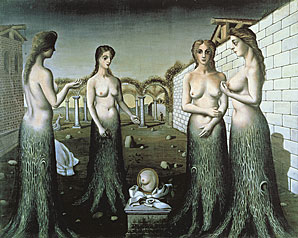
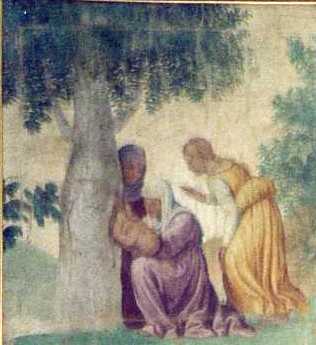
Paul Delvaux: Aurora B. Luini: The Birth of Adonis (The tree is Myrrha)
On Trees and on Birds (and on Flowers)
August 29, 2004
Modified on June 29, 2005
Sorrow is knowledge: they who know the most
must mourn the deepest o'er the fatal truth,
the tree of knowledge is not that of life.
[Byron: Manfred, Act I, Scene I.]
For trees as symbol of the female body, and more specifically
of her fantasized penis, there are numerous mythical and biblical associations.
Freud writes of a neurotic child who in his fantasies
identified the tree with his mother's body (Sigmund Freud, "An Infantile
Neurosis", in The Standard Edition of the Complete Works of Sigmund Freud, Ed. and Trans. J. Strachey, Hogarth Press, London 1963, Vol. XVII, pp. 85 -6). To the child, inflicting a wound on the tree was equivalent
to injuring his mother. In the same context (op.cit. Note 1), Freud mentions the epic poem
by the Italian poet of the late Renaissance, Torquato Tasso, Jerusalem
Delivered, in which Tancred hits the tree by his sword, and the tree starts
bleeding: he had wounded his beloved Clotild.
Theodor Reik has shown in Myth and Guilt, ( Braziller,
New York 1957) that the Tree of Knowledge is the body and the genital of
the Primeval Father. Henceforth, the Original Sin (eating of the Tree of
Knowledge) was an act of aggression and cannibalism perpetrated on the
genital of the Father. It is not casual that Jews, Christians, and Muslims atone for the Primeval Sin fasting: The Kippur - the Lenten Fast - Ramadan.
According to the archaic Law of the Talion, the substance of the atonement must be directly connected to the substance of the sin. If they atone by fasting, the sin must have been one of devouring.
However, there were two trees in the Garden of Eden:
The Tree of Knowledge, and the Tree of Life. The former is the Father,
and the latter is the Mother. That is the reason why the Lord was concerned
that Man would eat from the Tree of Life only after he had taken possess
of the Tree of Knowledge, namely, of the sexual knowledge which belongs
to the Father (his genital):
"Then the Lord God said: "Behold, the man
has become like one of us, knowing good and evil; and now lest he put forth
his hand and take also of the tree of life, and eat, and live for ever""
(Gen. 3:22). Knowing good and evil; the Bible itself tells to us that knowledge is a genital feature, as is written:
"Now Adam knew
Eve his wife, and she conceived" (Gen. 4:1), and again: "Cain knew
his wife, and she conceived" (Gen. 4:17), and again: ""Where are the men
who came to you tonight? Bring them out to us, that we may know them" (Gen.
19:5). The Sodomites wanted to sodomize
In archaic psyche, as in our unconscious, identification
is reached through introjection (internalization). Cannibals, who eat
their enemies, feel that they also acquire the properties of the introjected
object. Eating the paternal genital means acquiring his sexual potency.
With that sexual potency, Man will be able to possess the Tree of Life
(the Mother).
I have discussed the symbolism of trees as paternal imagines in Pinocchio and the Cult of the Trees
In the Peloponnese, Artemis was worshipped as “goddess
of the cult of the tree”.
In Greek myth, Daphne, in order to flight from Apollo's
desires, transforms into a tree.
On Myrrha and the birth of Adonis:
Cinyras, ruler of Paphos on Cyprus (and a direct descendant of the sculptor Pygmalion, whose statue came to life), had a daughter named Myrrha. Because she neglected the proper worship of Aphrodite, the goddess punished Myrrha by causing an insatiable lust for her father Cinyras. Knowing that he would never approve of incest, she deceived him by disguising herself as someone else, but after he learned of the deception he was so enraged he pursued his daughter intending to execute her. She prayed to the gods for some escape, and she was transformed into the myrrh tree (from her name Myrrha).
Myrrha is a tree, and as such she behaves:
Despite her transformation, Myrrha produced a son, named Adonis, who grew up to become the handsomest man of all time. Here we see the scene of his unusual birth in a pen drawing by Poussin . Note the presence of Aphrodite and her attendants, the three Graces.(From Adonis, Demeter (Ceres) & Persephone, Dionysus (Bacchus))
And like as when a mightye tree with axes heawed rownd,
Now redy with a strype or twaine to lye uppon the grownd,
Uncerteine is which way to fall and tottreth every way:
Even so her mynd with dowtfull wound effeebled then did stray
Now heere now there uncerteinely, and tooke of bothe encreace.
No measure of her love was found, no rest, nor yit releace... (Ovid, Metamorphoses , 10.244)
The analogy between the Greek myth and the biblical story of the daughters of Lot and their incestuous drive is very interesting (Gen. 19:30-37). The same girl's craving to possess the father, and the same deceptive ways in order to achieve the aim.
As we shall see below, the story of the girl craving to receive a child, as a gift, from the father, is narrated in the Christian myth of the Magi bringing gifts to the Virgin.
In Sumerian myth, the tree belongs to Inanna, who plants
it in her sacred garden. The myth is parallel to Greek Esperides, who lived
by a sacred tree by the golden fruits. These myths are similar to the biblical
story of Eve and the tree in the Garden of Eden, although the biblical
story is the result of a compressed condensation.
The fertility goddess Asherah, the sacred prostitute, was worshipped by the Hebrews as a sacred pole, namely a tree,
which was synonymous of the goddess, as narrated in Gideon’s story, who
had in his yard the image of Baal and the pole of Asherah (Judges 6: 25).
When the king of Judah, Josiah, about five hundreds years
after Gideon's story, enforces the first substantial religious reforms, the
Bible tells us that he cut the sacred poles of Asherah, of which the hills
around Jerusalem where plentiful (2 Kings 23:14)
Cutting, namely, castrating, was equivalent to desecrating
the goddess.
The book of Deuteronomy which, according to Wellhausen, has been composed in the same late days of the kingdom of Judah, says: "Thou shalt not plant an Asherah of any kind of wood beside the altar of the Lord" (Deut. 16:21). In Hebrew, there is one word, 'Etz, for wood and for tree. Furthermore, Freud has shown that wood and other primal materials are the symbol of the woman (S.Freud, "Symbolism in Dreams", 1915 - 17, in op.cit. Vol.XV, p. 158).
As the Bible explicitly tells us, despite Josiah reforms, at the eve of the First Exile the Jews were still worshiping the goddess, to the great dismay of the Prophets, who were struggling to uproot the Mother image from Jewish cult.
In archaeological excavations, it has been found that in the fifth century B.C., at Elephantine in Higher Egypt, a colony of Jewish mercenaries at the service of the Persian governor of Egypt were worshiping Jahveh and Asherah in the same temple as a sacred couple. They were not noticed of the monotheistic religious reforms, which had taken place in Judah after the return from the Babylonian exile a century earlier. Henceforth, they had been continuing to worship according to the previous Jewish rites, of which the cult of Asherah was a pivotal part.
Hundreds of years after Josiah purified Jerusalem
from the symbols of the Mother Goddess, and she was energetically repressed
in Jewish psyche after the Babylonian exile, the psychic need emerges from the repression through
the symbol of the Torah, that Theodor Reik has decoded as the symbol of
the maternal body ("The Re-Emerging Mother-Goddess" in Pagan Rites in Judaism,
Farrar Straus and Company, New York 1964, pp. 66 - 68). As is written:
“Hear, my son, your father's instruction, and
reject not your mother's Torah” (Prov.1:8) and again in 6:20.
So says Rabbi Shimon Bar Yiochai:
“Every
tree represents the Torah” (Bereshit Rabah 12:6).
In the Midrash (Jewish legends), the Torah is associated
35 times to the Tree of Life.
The associative chain is enlightening: Asherah
= Tree = Torah.
Furthermore, In the legends we are told:
In the beginning, two thousands years before the heaven and the earth, seven things were created: the Torah written with black fire on white fire, and lying in the lap of God […]
When God resolved upon the creation of the world, He took counsel with the Torah […]
The advice of the Torah was given with some reservation. She was sceptical about of an earthly world…
(Louis Ginzberg, The Legends of the Jews ,The John Hopkins University Press, Baltimore 1998, vol.1, p.3.)
We can see that the Torah is indeed a parental instance, like a wife of God, and therefore mother of man. She underwent a strong process of personification.
When the Jews, every Saturday morning, raise the Scrolls of Torah to display them publicly, they also restore the Torah to her role as Asherah, the sacred pole. It represents a symbolic repetition of the cult of the primal Mother Goddess, under the disguise of the Scrolls of the Law, captured from God, the Father, by Moses on the sacred mountain, in the name of the congregation of the Brotherhood Horde.
As reported by W.Robertson Smith, the most outstanding scholar of Semitic religion, in pre - Islamic Arabia a sacred date - palm was worshipped at Nejran:
It was adored at an annual feast, when it was all hung with fine clothes and women's ornaments. A similar tree, to which the people of Mecca resorted annually, and hung upon it weapons, garments, ostrich eggs and other gifts, is spoken in the traditions of the prophet under the vague name of a dhat anwat, or "tree to hang things on". It seems to be identical with the sacred acacia at Nakhla in which the goddess Al - 'Ozza was believed to reside ("Sacred Trees", in Lectures on the Religion of the Semites, Lect. V., Schocken, New York 1972, p.185)
In
Pinocchio and the Cult of the Trees, I have compared the Tree of Christmas with the cult of pines and firs that in Hellenistic Syria was associated with Dionysus, and was celebrated through torchlight - processions (the candles of the Christmas tree), because it occurred during the solstice of winter (as Christmas).
However, from Robertson Smith's quote, we can learn that the sacred trees, on which were hung gifts, were dressed with women's clothes and ornaments.
Therefore, the Christmas Tree, even if it is associated with Dionysus, has also a female connotation. It seems that it represents a condensation of Father, Mother, and Son, as it occurs in dreams' condensations.
We have seen that for the Hebrews, the Sacred Tree was Asherah, the sacred prostitute, which after the First Exile transfigured into the symbol of the Scrolls of the Torah. They too, like the sacred trees worshipped in Arabia, are dressed with clothes and are adorned with ornaments suitable to a woman.
Robertson Smith continues:
As regards the Poenicians and Canaanites we have testimony of Philo Byblius that the plants of the earth were in ancient times esteemed as gods and honored with libations and sacrifices, because from them the successive generations of men drew the support of their life. To this day the traveler in Palestine frequently meets with holy trees hung like an Arabian dhat anwat with rags as tokens of homage (op.cit. p.186).Now we can understand the latent meaning of gifts hung on the Christmas Tree or laid at its feet. At the manifest level the gifts are intended for the members of the family and friends, but they originally were intended as gift to the tree itself which, as we have seen, is the god.


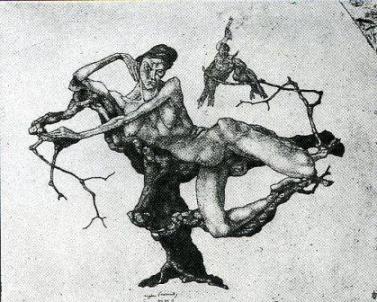
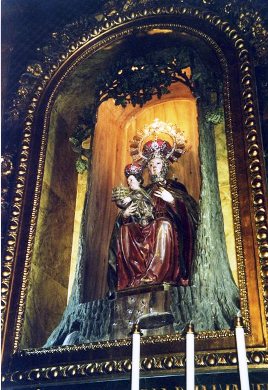
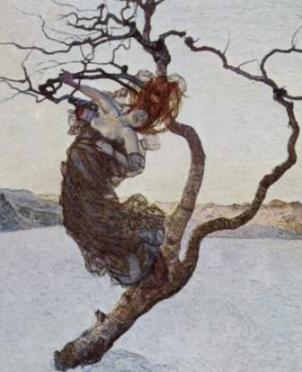
As the wisest man said:
"Hope deferred makes the heart sick, But when longing is fulfilled, it is a tree of life". (Proverbs 13:12)
On Birds
We have seen that trees are both the symbol of the penis
of the Father (the Tree of Knowledge) and of the Mother (the Tree of Life),
according to the context.
The Roman eagle, which is the model of the Byzantine and
Habsburg empires, was a paternal phallic symbol, apotropaic (mean of defense)
tool against internal and external enemies.
Freudian “Uncanny" (Das Unheimliche) * is the
thread of one of the most famous films by Alfred Hitchcok: “The Birds”.
Penises, paternal and maternal in the same condensation, are menacing
and threatening. The birds unconsciously remind the primal sin of profanation
and castration of the paternal genital. Henceforth, they are the vector
of the Father’s Talion, like in Prometheus’ myth.
In the same way, birds, which are an obvious phallic symbol,
are both males and females.
I have emphasized the female symbolism of birds in The Israelites and the Quails. Primal Mothers are represented as birds because children believe that the female had possessed a member like that of the male, even much bigger (K. Abraham, "An Infantile Sexual Theory not Hitherto Noted" (1925), in op.cit. p. 336).
Zeus’ eagle was his phallic symbol, like Hermes, the winged
god, who is his extension and erection, and the doer of Zeus’ will.
Majestic and threatening, the bird of the Father of the
Gods punishes Prometheus, the impertinent vicar of the Brotherhood Horde,
visiting him daily and devouring his liver, symbol of castration, and Talion
for the sacrilege perpetrated by the Titan. The ancients believed that the liver is the member which harbors emotions. Just like - until recently - we believed that the site of feelings is the heart. Therefore, it is a displacement from the genital, which actually is the member erecting toward the ones whom we love (Cf. S.Freud, The Acquisition and Control of Fire (1932 [1931]).
“Les Mouches” by Sartre, inspired by Aeschylus'
classic tragedy, "The Orestia", retraces the same theme of Hitchcok’s “The
Birds”. An invasion of little fastidious creatures, which reconnects us
to our archaic and uncanny sense of guilt.
Elizabeth Vlossak writes in
"Les Mouches/The Flies" (ArgosyNet ): “In Sartre's rendition, Orestes, like
the Pied Piper of Hamlin, must leave Argos, leading away with him the flies
of guilt in order to finally free his city of the curse of the House of
Atreus, which had infected Argos since the killing of King Agamemnon”. She draws a comparison between Sartre’s “Les Mouches” and the Pied Piper of Hamlin, associating them to a collective sense of guilt.
Elizabeth Vlossak correctly associated the timing of Sartre’s play to Nazis’ occupation of France. However, she states that the author
wanted to help rekindle French national pride in presenting a familiar story with a hidden political and very satirical twist, for it would have been quite obvious, at least to French theatre-goers of the time, that through "Les Mouches" Sartre was attacking the brutality of Nazi occupation, as well as the indifference of the Vichy government. Sartre also used this play to explain Existentialism, a philosophy in which argues, among other things, that all men are born free but that this freedom is in fact a burden, a curse.
It seems to me that she missed the main point. The association between Nazi’s brutal occupation and a collective sense of guilt is a good start, but the supposed hidden political statement is a rationalizing overlay. The latent meaning of the play is that the brutal Nazi occupation was unconsciously interpreted by the collective mind of the French (and Sartre, as every artist, is a delegate of the people to represent their unconscious needs) as a punishment for a foggy and undefined sin. The sense of guilt is always there, but misfortunes trigger its activation, because are unconsciously interpreted as its confirmation.
Repression and occupation, being interpreted as a punishment, rekindled the latent sense of guilt, which found its expression in Sartre's play.
“The Birds” by Hitchcok reminds the Pied Piper of
Hamlin, too. A myriad out of control of little creatures, intruding and menacing,
threatens the peace of mind of a community, which, until then, had apparently
been undisturbed. The rats, another symbol of the penis, which, in the
context of The Pied Piper of Hamlin, I interpreted as female, but that
condense also the castration threat by the Father for the archaic desecration,
intrude in an obsessive way into the psychic equilibrium of the community.
The birds are also messengers of good news. According
to the Roman legend the two twins, Romulus and Remus conceived an original
way for determining who would be the ruler of Rome. Romulus stood
on the Aventine hill and Remus stood on the Palatine and which ever hill
the birds flew over, that brother would rule. It was said to be a message
from the gods. After a long time, six birds flew over the Palatine hill
where Remus was standing, and so he thought he would rule, until twelve birds
flew over the Aventine hill where Romulus stood, and so he ended up ruling
Rome.
Namely, the possessor of the larger number of birds (penises)
is the one entitled to rule.
However, we use to say: “Bird of ill - omen”. Therefore,
the bird – penis may be benevolent, but also malevolent. Benevolent and
salvific, like the pigeon, symbol of peace and of the Holy Ghost, and like
Noah's pigeon which was sent from the Ark to test God's good will in pardoning
His sons, and to see whether the waters had retrieved from the dry land.
Malevolent and punishing like the bird sent by Zeus to devour Prometheus’
liver, and the birds from Hitchcok' film.
Prometheus is the prototype of the Christ, before the compromise between Father and Son was worked out, as it later occurred in Christian tradition.
He was condemned to stay chained to his Cross (the rock), for having defiled the Father (Zeus). Christ atoned, and he sits Dextera Patris (at the right of the Father).
As I have shown in Pinocchio and the Cult of the Trees, the Tree of the Cross, to which Jesus was hanged is equivalent to Prometheus' rock, to which he was chained. The bird, which daily comes to devour Prometheus' liver, is Zeus' phallic symbol. Indeed, the eagle is the symbol of Zeus. In many paintings, we still can see the dove, symbol of the Holy Ghost, standing on the top of the Cross. The bird only transfigured from threatening and malevolent into "dovish" and benevolent. The original meaning has been repressed, but the bird is still there.

The bird, as a symbol of the paternal penis, reconnects to another aspect of Christian mythology, which now can be better understood.
Freud has shown that the child perceives females possessing a penis like his own, and he fantasizes the act of deflowering as a castration inflicted by the male through sexual intercourse. (S.Freud, "The History of an Infantile Neurosis", in op.cit. Vol. XVII, pp.121-2).
The Virgin is considered the perfect - purest - ideal woman. Perfection, in our unconscious, means "an untouched genital". As pointed by Abraham: "The female genital is looked upon as a wound, and as such it represents an effect of castration" (Karl Abraham, "The Female Castration Complex", 1920, in op.cit. p.340). A deflowered woman is unconsciously perceived as "wounded", namely, deprived of her virginal penis.
Therefore, the Virgin is perfect and pure because she was not deprived of her fantasized penis through sexual intercourse. Purity, perfection, and virginity are unconsciously equivalent.
However, the ideal is always an Ego fabrication. In our unconscious, we know that, having been impregnated by the Holy Ghost, she should have had some sort of contact with a penis. That unconscious knowledge emerges from the repression through the representation of the Holy Ghost as a bird, namely, a penis.
No matter how strongly religious faith imposes an Ego overlay on the unconscious knowledge through dogmatic assumptions, the latter pressures for relief, until it emerges through a symbol: the bird visited her, after all.

And on Flowers
Notice the flowers at the bottom left of the painting. Flowers hint at the deflowering of the Virgin **.
The Annunciation by Simone Martini
Flower Theology
When young, a flowery cavern home - when old, a dragon on the roam
(F.Nietzsche, "Seven Short Maxims About Women", in Beyond Good and Evil, 237)
It is not casual that men use to bring flowers to women, and not the other way around. It hints at their intention of deflowering them, indeed.
After all, poets know better:
Then let thy love be younger than thyself,
Or thy affection cannot hold the bent:
For women are as roses, whose fair flower,
Being once displayed doth fall that very hour.
(Shakespeare, Twelfth Night, Act II, scene 4).
Women are roses, whose fair flower...doth fall that very hour, namely, women are flowers whose virginity falls when the right moment is due.
As pointed by Karl Abraham, deflowering is psychically equivalent to castrating the female ("The Female Castration Complex" (1920), in op.cit. , pp. 339 - 343).
Flowers - Still life: symbol of female castration.
Still life in other langages is named "Dead Nature" (Natura morta - Nature morte, etc), confirming Freud's insight that death and castration are psychically equivalent ("The Uncanny" [Das Unheimliche], 1919).
In myths, tales, and poems, virgins spend their time picking up flowers, which, as Freud has shown, are the symbol of their virginity, (usually in the bush, which is the symbol of the female genital *** ) awaiting for a hero or a prince who will come and deflower them. Little Red Riding Hood is killed - deflowered by the wolf, which is a paternal castrating imago, and "saved" by the prince - hunter. The same paternal image is split into two different roles, as in many other tales. Snow - White picks up flowers, then she dies and resurrects, like Little Red Riding Hood. Being deflowered condenses castration, death and salvation.
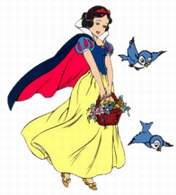
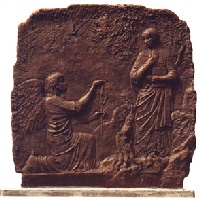
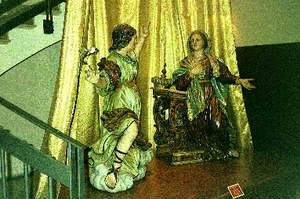
In archaeological excavations in the Middle East, we find statuines and reliefs of female figures, which represent Astarte and Asherah, the goddess patroness of the sacred harlots. In the area of the semitic fertile crescent, Temple prostitution was part of fertility cults.
At Tell Beit Mirsim, South - West of Jerusalem, W.F.Albright found a serie of statuines of naked women, dating back to the end of the second millenium B.C., representing the goddess holding a lotus flower, hinting that deflowering was part of these cults.
W. Robertson Smith reports: "the female worshippers at the Adonis feast of Byblos who[...] were required to sacrifice either their hair or their chastity, appear, from other accounts to have been generally maidens, of whom this act of devotion was exacted as a preliminary to marriage" (Lectures on the Religion of the Semites, Lect. IX, Schocken, New York 1972, p. 329). In note number 3, Robertson Smith adds: "Cf. Socrates, i. 18, and similar usage in Babylon, Herod. i. 199. We are not to suppose that participation in these rites was confined to maidens before marriage (Euseb. Vit. Const. iii. 58. 1), but it appears that it was obligatory on them"
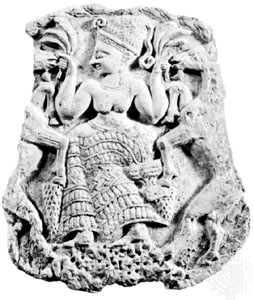
* Sigmund Freud, “The Uncanny” ( 1919): “The Uncanny is that class of the frightening which leads back to what is known of old and long familiar”.
** As pointed by Freud: "Blosssoms and flowers indicate women's genital, or, in particular, virginity" ("Symbolism in Dreams", 1915 - 17, in The Standard Edition of the Complete Works of Sigmund Freud, Ed. and Trans. J. Strachey, Hogarth Press, London 1964, vol.15, p.158).
*** Op.cit.
Links:
Caravaggio, Clitoridectomy and the Talion of the Woman
Hamlet. The Puberty Rite of a Danish Prince and His Companions
Myth and the Cloacal Theory
Little Red Riding Hood
Cinderella and the Puss with the Boots
Pinocchio and the Cult of the Trees
Three Women: the Penis
The Israelites and the Quails
Medusa, the Female Genital, and the Nazis
Maestri and Disciples
Biancaneve e altre vergini